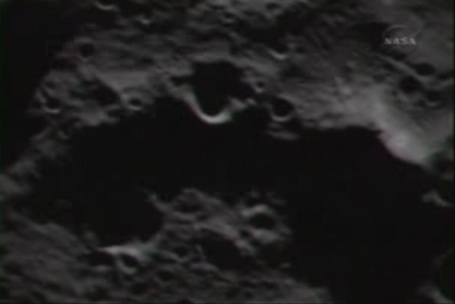LCROSS has just crashed into Cabeus crater on the Moon four minutes after the Centaur upper stage crashed, too. During the four minutes, LCROSS observed the plume that the upper stage kicked up and hopefully getting data that confirms the existence of water. The spacecraft had separated from the Centaur upper stage almost ten hours previously, after which they traveled almost 10,000 kilometers before reaching the Moon. NASA TV had just broadcast the impact live, and it’s impressive how much media attention the LCROSS impact has grabbed. I had thought only space enthusiasts such as myself would have paid any attention to it.

LCROSS was launched in June along with the Lunar Reconnaissance Orbiter. Its origin is rather interesting: the rocket purchased for launching the LRO had some lift capability left over, so LCROSS was created on the cheap to take advantage of the excess rocket power. It had spent over three months in a large orbit around the Earth, an orbit which has just now intersected the Moon. The orbit not only made the impact more powerful, but the three months were also spent baking volatiles such as water away from the Centaur upper stage. Without the baking, any water detected could have been due to contamination from the Centaur upper stage, which would have interfered with the whole point for LCROSS.
Speaking of contamination, it’s a little annoying with how many people called the LCROSS impact a “bombing” of the Moon. Lightheartedly calling it a “moon bombing” is actually fine with me, but what annoys me is the lack of followup that it’s not really a bombing. A bombing involves explosives, and it would be really silly to contaminate the plume the Centaur upper stage kicks up with chemical explosives. The impacts are really not very different from the myriad of other impacts that strike the Moon all the time, it’s just that LCROSS is positioned at the right time at the right place to observe it closely.
As I watched LCROSS close in on the Moon via NASA TV, it was a little disappointing that no visible plume from the Centaur upper stage impact could be seen, but it was still a tense moment. Fortunately, all the instruments on LCROSS seemed to have been working properly right until the moment of impact. After the hours of downloading the data and the days or weeks analyzing the data, hopefully we will have a definitive answer as to whether significant reservoirs of water exist around the lunar south pole. Regardless of whether LCROSS detected water or not, it would still be a significant scientific result, although manned lunar exploration would obviously get a boost if there is water on the Moon.
To learn more about the LCROSS mission, go to the LCROSS website or watch the following four-minute video NASA created to show how the mission happened:
And NASA has already put up video taken by LCROSS right before the impact: